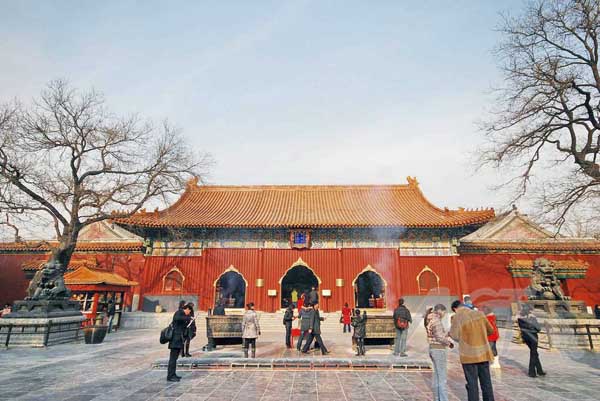Yonghe Lamasery
Built in the early Qing Dynasty, the Yonghe Lamasery was originally built as an imperial prince’s palace. It became the national center of Lama administration and is the best preserved lamasery in China. No expense was spared in the construction of the complex. It is a stunning example of Chinese imperial architecture and features Tibetan, and Qing Dynasty imperial architectural styles. The lamasery occupies an area of over 66,400 square meters and consists of five main halls and a large number of secondary halls.
History
Built in 1694 by Emperor Kangxi (r.1661-1722) for his son, and crown prince, Yinzhen, who eventually became the Emperor Yongzheng, (r.1722-1735). During Emperor Yongzheng’s reign, the residential area of the palace was maintained as a temporary palace for the emperor, and the other half was turned into a lamasery. It was intended to be used as a place for the recitation of scriptures. In 1725, the palace was burned to the ground and the lamasery was renamed Yonghe, which means “Harmony and Peace”.
Layout
The Yonghe Lamasery features five main halls and a number of lesser halls. The halls of the lamasery are decorated with Han and Tibetan Buddhist sculptures and frescoes. The halls are home to a large collection of Buddhist Sutras written in four languages; Manchu, Han, Tibetan, and Mongolian.
Falun Hall
The main hall of the Yonghe Lamasery, Falun Hall is unique in the lamasery for its layout and design. The hall is built with a gilded vase and five copper gilded, Tibetan styled towers on its roof. The hall was the location for Lamas to read Buddhist Sutras and conduct ceremonies.
Located in the center of the hall, is a 6.1 meter high sculpture of Lama Tsongkhapa, sitting on a giant lotus base. Lama Tsongkhapa was the founder of the Gelug sect of Tibetan Buddhism. Behind his sculpture is a mountain with 500 Arhats carved of red sandalwood. Each Arhat is unique and was crafted of gold, silver, copper, iron, and tin. Located in front of the mountain is a wooden basin. According to tradition, this basin was used to bath Emperor Qianlong three days after his birth.
Large frescoes depicting the life of The Buddha wrap around the east and west walls of the hall. In the east and west wings of the Falun Hall are sermon platforms, intended to be used by the Dalai Lama and Banchen Lama to give sermons.
Tianwang Hall/Yonghe Gate
The first hall of the Yonghe Lamasery, Tianwang Hall is also known as the Yonghe Gate. Located in the exact center of the hall is a gilded sculpture of Monk Budai, with the four Heavenly Kings located on either side of him. The Heavenly Kings look ferocious, but they only punish the evil. The northern Heavenly King located on the eastern side holds a snake. The northern Heavenly King located on the western side holds a Pipa, a Chinese Lute. The southern Heavenly King located on the eastern side holds an umbrella and a silver mouse. The southern Heavenly King located on the western side holds a sword.
Zhaotai Gate
Mounted with three gatehouses, the Zhaotai Gate is the front gate of Yonghe Lamasery. The gate has three arched openings guarded by huge wooden doors. The central opening was for the exclusive use of the emperor. Located in front of this gate are a drum tower, a bell tower, and two stele pavilions.
Yonghegong Palace
The main palace of the Yonghe Lamasery, Yonghegong is an incredible building. Located inside the palace are statues of Kasyapa Mantanga, Maitreya, and The Buddha. The three Buddhas are incredible works of art. On both sides of the hall are 18 Arhats, which are The Buddha’s disciples.
Yongyoudian Hall
Originally, Emperor Yongzheng’s living room, and the place where his coffin was placed before being moved to his tomb, Yongyoudian Hall houses a statue of Bhaisajya-guru.
Wanfuge Palace
The tallest building in Yonghe Lamasery, Wanfuge Palace is also one of the most impressive. Located on either side of the palace, connected by bridges are Yanningge, and Yongkangge pavilions. Inside Wanfuge Palace are tens of thousands of images of Buddhas on every level. Located in the center of the palace is a gigantic statue of the Tathagata Buddha standing on a white marble base. Carved from a single piece of sandalwood, the statue is 26 meters high and 8 meters in diameter.
There are many other building located in the lamasery and each is works of art in their own right. They are wonderful to explore and are filled with artistic treasure.







